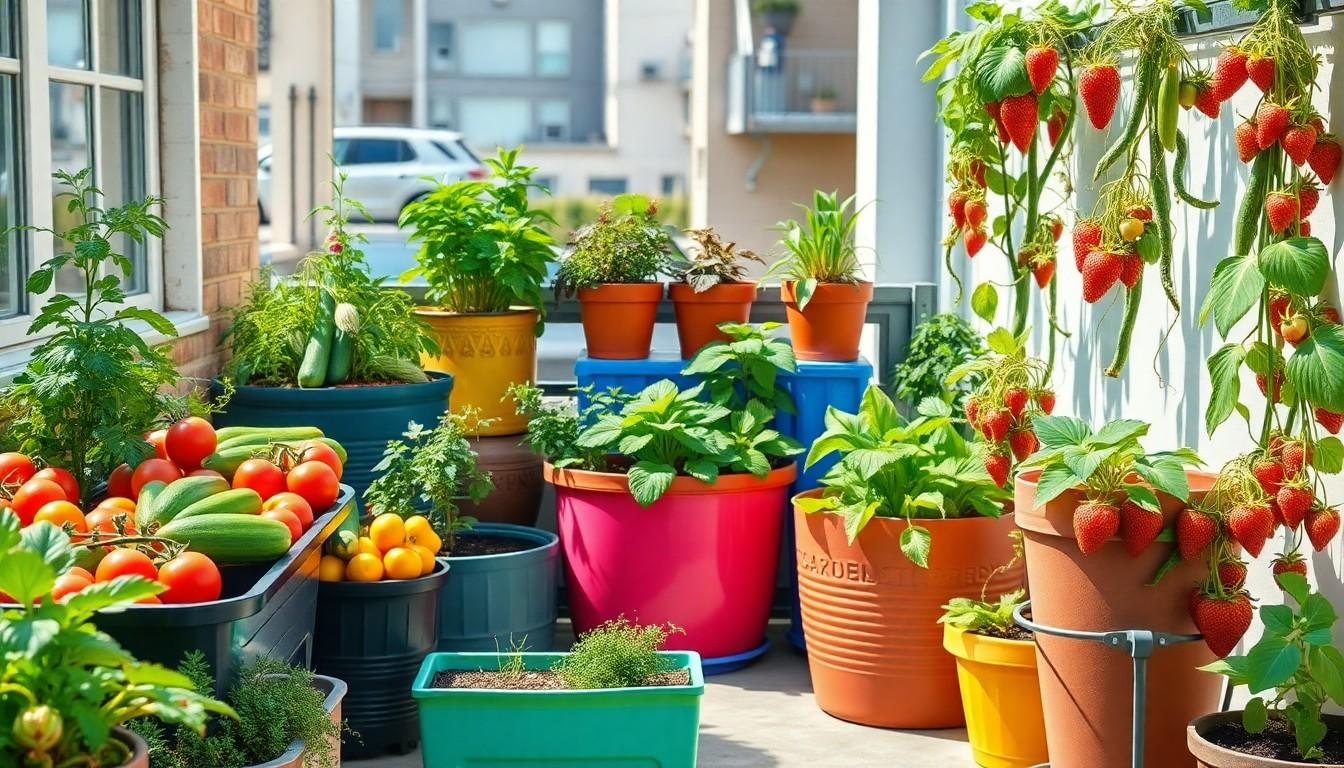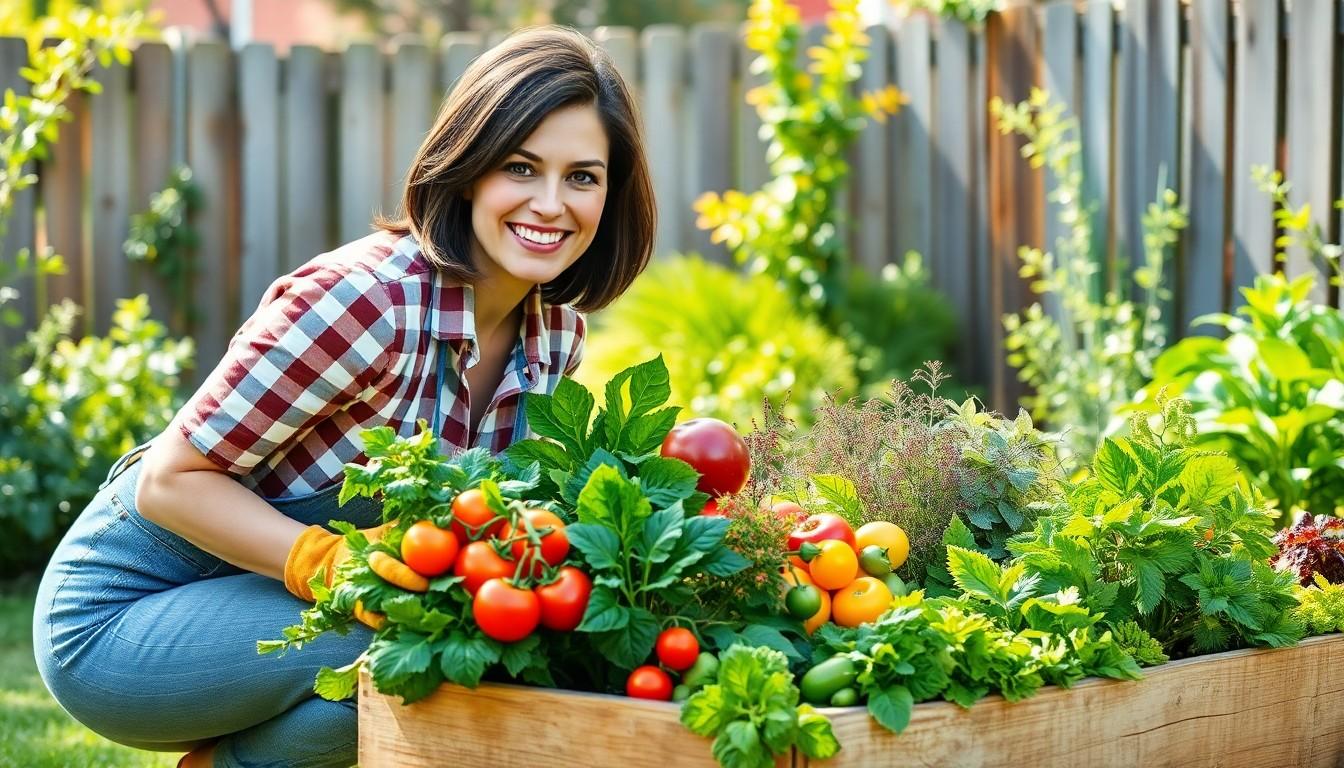Imagine stepping into your backyard and being greeted by a vibrant vegetable garden, bursting with fresh produce just waiting to be harvested. With a vegetable garden planter, that dream can become a reality, even if you think your thumbs are more brown than green. These handy planters are the perfect solution for anyone looking to grow their own veggies without the hassle of traditional gardening.
Not only do they save space, but they also keep pesky weeds at bay and make gardening accessible to those with limited mobility. Plus, who wouldn’t want to impress friends with homegrown tomatoes while secretly reveling in the fact that they didn’t have to dig up half the yard? Dive into the world of vegetable garden planters and discover how easy it is to cultivate a little slice of paradise right at home.
Overview Of Vegetable Garden Planters
Vegetable garden planters offer a practical solution for cultivating homegrown produce. Various types exist, including raised beds, containers, and vertical planters. Each type provides unique benefits, catering to diverse gardening needs.
Raised beds enhance drainage and soil quality, making them ideal for many vegetable types. Such structures enable easier access and maintenance, proving useful for gardeners with limited mobility. Containers, on the other hand, allow for more flexibility in plant placement. They suit urban environments with restricted space and can be moved to optimize sunlight exposure.
Vertical planters maximize space by utilizing upward growth. These designs create an eye-catching display while offering an efficient way to grow herbs and vegetables. Engaging in such gardening techniques leads to increased yields and improved aesthetics.
Selecting the right planter requires considering factors like size, material, and plant variety. Durable materials, such as wood, plastic, or metal, contribute to longevity. Drainage holes and proper soil depth ensure plants receive adequate water and nutrients.
Budget constraints often influence planter choices. It’s possible to create DIY options using recycled materials, such as pallets or old containers. This approach not only saves money but also promotes environmentally friendly practices.
Individuals interested in starting a vegetable garden typically find planters to be an accessible and rewarding choice. Growing fresh vegetables at home becomes achievable with minimal effort, allowing anyone to enjoy the satisfaction of harvesting their own produce. Overall, vegetable garden planters simplify the gardening experience while providing substantial benefits.
Types Of Vegetable Garden Planters

Various types of vegetable garden planters cater to different needs and available spaces. Each option provides unique benefits, making gardening accessible for everyone.
Raised Bed Planters
Raised bed planters enhance drainage and soil quality. They feature elevated structures that promote better root growth. Vegetables flourish in the nutrient-rich environment these beds provide. Mobility challenges present no barriers, as gardeners can comfortably reach plants. Typically, sizes range from 4 feet by 4 feet to larger configurations, supporting a variety of crops like tomatoes and zucchini. Additionally, these planters prevent soil compaction and reduce weeds, streamlining maintenance efforts.
Container Planters
Container planters offer flexibility in plant placement. They suit urban environments where space is limited. A wide array of materials like plastic, wood, and ceramic allows for customization. Choices contribute to aesthetic appeal while supporting diverse plant varieties. Sizes vary from small pots to large barrels, accommodating everything from herbs to root vegetables. Easy to move, containers enable repositioning to optimize sunlight exposure throughout the day.
Vertical Planters
Vertical planters maximize space efficiency while creating stunning displays. These innovative designs use vertical structures to support climbing plants and tiered arrangements. Individuals with limited gardening space benefit from their ability to fit in small areas like balconies or patios. Common options include wall-mounted systems and freestanding towers. Crops such as strawberries, beans, and lettuce thrive in these setups. Accessibility for maintenance remains essential, as vertical planters allow easy reach of plants at varying heights.
Key Features To Consider
Choosing the right vegetable garden planter involves evaluating key features. These criteria affect plant growth and maintenance.
Material Choices
Various materials exist for garden planters. Wood is popular due to its natural aesthetic and insulation qualities. Metal offers durability and a modern look, while plastic provides lightweight options that resist weathering. Each material has unique pros and cons, so understanding individual needs guides the selection.
Size and Depth
Size affects the types of vegetables grown. Smaller planters suit herbs or compact plants, while larger ones accommodate root vegetables. Depth matters significantly for root development; deeper planters allow roots to expand, promoting healthy growth. Consider available space and intended plants to determine the right dimensions.
Drainage Options
Proper drainage prevents waterlogging in vegetable garden planters. Look for designs featuring drainage holes or those incorporating gravel layers. Good drainage ensures roots receive necessary oxygen while excess water drains away. Implementing various drainage solutions fosters a healthy growing environment, enhancing yields.
Benefits Of Using A Vegetable Garden Planter
Using a vegetable garden planter offers multiple advantages for home gardeners. Enhanced accessibility stands out as a primary benefit, as planters eliminate the need for bending down, making gardening tasks manageable for individuals with limited mobility.
Flexible placement options allow gardeners to position planters based on sunlight availability or aesthetic preferences. Container planters adapt to various settings, whether a balcony, patio, or small yard, ensuring that space constraints don’t hinder gardening efforts.
Improved soil quality and drainage are crucial considerations. Raised planters prevent soil compaction, promoting healthy root development for diverse crops. This design fosters an optimal environment for vegetables to thrive, leading to increased harvests for gardeners.
Efficient watering practices lead to better plant health. Planters often retain moisture more effectively than traditional garden beds, reducing the frequency of watering sessions. This feature proves essential for maintaining vibrant and healthy plants.
Variety in planter choices enables customization. Gardeners select designs that align with their needs, from vertical planters maximizing limited spaces to wide containers accommodating larger root vegetables. This adaptability enhances the overall gardening experience.
Implementing organic gardening practices becomes simpler with planters. Pests and diseases can be managed more effectively when plants grow in defined areas, leading to healthier produce. By controlling the growing environment, gardeners can cultivate a thriving vegetable garden with ease.
Overall, the benefits of using a vegetable garden planter include increased accessibility, improved soil conditions, efficient watering, personalized designs, and better pest management. Each of these factors contributes to a successful and enjoyable home gardening experience.
Tips For Successful Gardening
Selecting the right location for a planter is crucial. Sunlight exposure determines plant growth, so a spot with at least six hours of direct sunlight daily benefits most vegetables.
Choosing quality soil enhances productivity. Organic potting mixes provide essential nutrients and improve moisture retention, ensuring healthy plants.
Watering techniques matter significantly. Consistent moisture prevents wilting while avoiding overwatering reduces the risk of root rot. A daily check on soil moisture helps determine the right schedule.
Fertilizing during the growing season promotes robust growth. Using slow-release fertilizers or organic options like compost enriches the soil, providing a steady nutrient supply.
Practicing crop rotation helps maintain soil health. Rotating crops each year prevents nutrient depletion and reduces pest infestations, enhancing overall garden resilience.
Pest management can be straightforward. Implementing physical barriers like row covers or using non-toxic sprays minimizes damage without harming beneficial insects.
Regular harvesting encourages more production. Picking ripe vegetables frequently signals plants to produce more, leading to a bountiful harvest.
Mulching around plants conserves moisture and suppresses weeds. Organic mulch materials, such as straw or wood chips, can enrich the soil as they decompose.
Finally, observing plants daily aids in identifying issues early. Regular checks allow for quick interventions, ensuring a flourishing vegetable garden throughout the season.
Conclusion
Embracing vegetable garden planters opens up a world of possibilities for home gardening. They simplify the process and make it accessible for everyone regardless of space or physical limitations. With a variety of options available each offering unique benefits gardeners can easily find the right fit for their needs.
The advantages of using planters extend beyond convenience. They promote healthier plants through improved soil quality and drainage while also allowing for creative gardening solutions in limited spaces. By considering essential factors like size material and plant variety anyone can cultivate a thriving vegetable garden.
Ultimately the joy of harvesting fresh produce right from one’s own garden is a rewarding experience. With the right planter and a little care it’s possible to enjoy the fruits of home gardening all season long.

